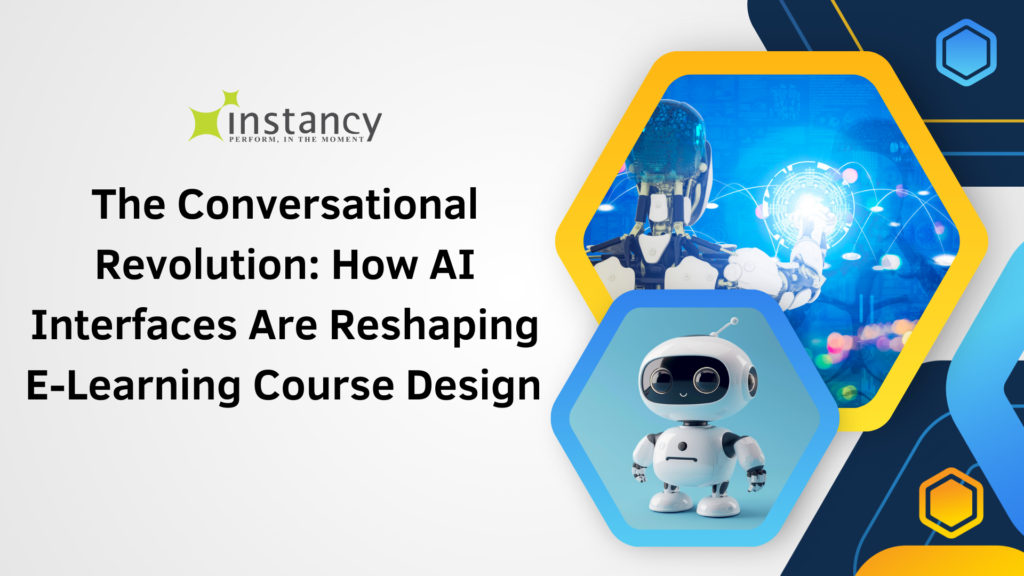Conversational interfaces are poised to revolutionize e-learning course design, offering a more personalized, engaging, and adaptive learning experience. This shift towards conversational AI in education is driven by advancements in natural language processing, machine learning, and user experience design. Let’s explore how these interfaces will influence e-learning and the design principles that will shape their implementation.
The Evolution of E-Learning Interfaces
- Chatbots: Text-based interfaces that simulate conversation with learners.
- Voice Assistants: Audio-based interfaces that use speech recognition and synthesis.
- Multimodal Interfaces: Combine text, voice, and visual elements for a comprehensive learning experience.
Impact on E-Learning Course Design
1. Personalized Learning Paths:
Conversational interfaces can adapt the learning journey based on individual student responses and progress. This personalization ensures that each learner receives content tailored to their knowledge level and learning style.
Pro: Improved learning outcomes through targeted content delivery.
Con: Complexity in designing courses that cater to diverse learning paths.
2. Interactive Content Delivery:
Rather than passive consumption of information, conversational interfaces encourage active participation. Learners can ask questions, seek clarifications, and engage in dialogues about the course material.
Pro: Enhanced engagement and better retention of information.
Con: Potential for distractions if not properly structured.
3. Real-time Assessment and Feedback
Conversational AI can continuously assess learner understanding through natural language interactions, providing immediate feedback and adjusting the difficulty level accordingly.
Pro: Timely interventions to address knowledge gaps.
Con: Challenge in accurately interpreting complex responses.
4. Accessibility and Inclusivity
Voice-based interfaces can make e-learning more accessible to learners with visual impairments or those who prefer auditory learning.
Pro: Broader reach and improved accessibility.
Con: Potential exclusion of learners with speech or hearing impairments if not designed inclusively.
User Interface Design Principles for Conversational E-Learning
1. Natural language Understanding (NLU)
Design Principle: Create interfaces that can interpret and respond to a wide range of natural language inputs.
Pro: More intuitive and user-friendly interactions.
Con: Complexity in handling diverse linguistic patterns and colloquialisms.
2. Context-Aware Responses
Design Principle: Develop AI that maintains context throughout the conversation, providing relevant and coherent responses.
Pro: More meaningful and productive learning dialogues.
Con: Increased computational requirements and potential for misinterpretation.
3. Adaptive Content Presentation
Design Principle: Dynamically adjust the presentation of learning materials based on user interactions and preferences.
Pro: Optimized learning experience for each individual.
Con: Need for extensive content variations to cater to different scenarios.
4. Multimodal Integration
Design Principle: Seamlessly combine conversational elements with traditional multimedia content like videos, graphics, and interactive exercises.
Pro: Rich, engaging learning experiences that cater to various learning styles.
Con: Increased complexity in design and potential for cognitive overload if not balanced properly.
5. Emotional Intelligence
Design Principle: Incorporate sentiment analysis to detect and respond to learners’ emotional states.
Pro: More empathetic and supportive learning environment.
Con: Privacy concerns and the risk of misinterpreting emotional cues.
6. Guided Discovery
Design Principle: Use conversational prompts to guide learners through exploratory learning experiences.
Pro: Encourages critical thinking and self-directed learning.
Con: Balancing guidance with allowing genuine discovery can be challenging.
7. Personalized Pacing
Design Principle: Adjust the speed and depth of content delivery based on individual learner responses and progress.
Pro: Optimized learning pace for each student.
Con: Ensuring consistent learning outcomes across varied pacing can be difficult.
Implementing Conversational Interfaces in E-Learning
The integration of conversational interfaces into e-learning courses requires a thoughtful approach that combines pedagogical principles with technological capabilities.
1. Blended Approach
Most effective implementations will likely use a hybrid model, combining pre-created multimedia content with dynamic conversational elements. This approach allows for quality-controlled core content while providing the flexibility and personalization of AI-driven interactions.
2. Scaffolded Learning
Conversational interfaces can be designed to provide varying levels of support, gradually reducing assistance as learners become more proficient. This scaffolding approach helps build confidence and independence.
3. Continuous Improvement
Machine learning algorithms can analyze learner interactions to continuously refine and improve the conversational interface, enhancing its effectiveness over time.
4. Data-Driven Insights
The rich data generated by conversational interactions can provide valuable insights into learning patterns, common misconceptions, and areas for course improvement.
Challenges and Considerations
While conversational interfaces offer exciting possibilities for e-learning, there are several challenges to consider:
- Data Privacy: Ensuring the security and privacy of learner data collected through conversational interactions.
- Technological Barriers: Not all learners may have access to the necessary technology or bandwidth for advanced conversational interfaces.
- Design Complexity: Creating effective conversational experiences requires expertise in both instructional design and conversational AI.
- Cultural Sensitivity: Ensuring that conversational interfaces are culturally appropriate and inclusive for diverse learner populations.
- Balancing AI and Human Interaction: Determining when AI support is sufficient and when human instructor intervention is necessary.
Conclusion
Conversational interfaces are set to transform e-learning course design, offering unprecedented levels of personalization, engagement, and adaptivity. By applying thoughtful design principles and leveraging the strengths of both AI and traditional instructional methods, educators and course designers can create powerful learning experiences that cater to individual needs while maintaining pedagogical rigor.
As this technology continues to evolve, we can expect to see increasingly sophisticated and effective conversational e-learning interfaces that blur the lines between instruction and dialogue, fostering a more natural and intuitive learning process. The key to success will lie in striking the right balance between technological innovation and sound educational practices, always keeping the learner’s needs at the center of the design process.



